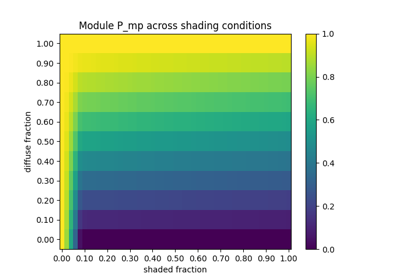pvlib.singlediode.bishop88_v_from_i#
- pvlib.singlediode.bishop88_v_from_i(current, photocurrent, saturation_current, resistance_series, resistance_shunt, nNsVth, d2mutau=0, NsVbi=inf, breakdown_factor=0.0, breakdown_voltage=- 5.5, breakdown_exp=3.28, method='newton', method_kwargs=None)[source]#
Find voltage given any current.
- Parameters
current (numeric) – current (I) in amperes [A]
photocurrent (numeric) – photogenerated current (Iph or IL) [A]
saturation_current (numeric) – diode dark or saturation current (Io or Isat) [A]
resistance_series (numeric) – series resistance (Rs) in [Ohm]
resistance_shunt (numeric) – shunt resistance (Rsh) [Ohm]
nNsVth (numeric) – product of diode ideality factor (n), number of series cells (Ns), and thermal voltage (Vth = k_b * T / q_e) in volts [V]
d2mutau (numeric, default 0) – PVsyst parameter for cadmium-telluride (CdTe) and amorphous-silicon (a-Si) modules that accounts for recombination current in the intrinsic layer. The value is the ratio of intrinsic layer thickness squared \(d^2\) to the diffusion length of charge carriers \(\mu \tau\). [V]
NsVbi (numeric, default np.inf) – PVsyst parameter for cadmium-telluride (CdTe) and amorphous-silicon (a-Si) modules that is the product of the PV module number of series cells
Nsand the builtin voltageVbiof the intrinsic layer. [V].breakdown_factor (float, default 0) – fraction of ohmic current involved in avalanche breakdown \(a\). Default of 0 excludes the reverse bias term from the model. [unitless]
breakdown_voltage (float, default -5.5) – reverse breakdown voltage of the photovoltaic junction \(V_{br}\) [V]
breakdown_exp (float, default 3.28) – avalanche breakdown exponent \(m\) [unitless]
method (str, default 'newton') – Either
'newton'or'brentq'. ‘’method’’ must be'newton'ifbreakdown_factoris not 0.method_kwargs (dict, optional) – Keyword arguments passed to root finder method. See
scipy.optimize.brentq()andscipy.optimize.newton()parameters.'full_output': Trueis allowed, andoptimizer_outputwould be returned. See examples section.
- Returns
voltage (numeric) – voltage (V) at the specified current (I) in volts [V]
optimizer_output (tuple, optional, if specified in
method_kwargs) – see root finder documentation for selected method. Found root is diode voltage in [1]_.
Examples
Using the following arguments that may come from any calcparams_.* function in
pvlib.pvsystem:>>> args = {'photocurrent': 1., 'saturation_current': 9e-10, 'nNsVth': 4., ... 'resistance_series': 4., 'resistance_shunt': 5000.0}
Use default values:
>>> v = bishop88_v_from_i(0.0, **args)
Specify tolerances and maximum number of iterations:
>>> v = bishop88_v_from_i(0.0, **args, method='newton', ... method_kwargs={'tol': 1e-3, 'rtol': 1e-3, 'maxiter': 20})
Retrieve full output from the root finder:
>>> v, method_output = bishop88_v_from_i(0.0, **args, method='newton', ... method_kwargs={'full_output': True})
Examples using pvlib.singlediode.bishop88_v_from_i#

Calculating power loss from partial module shading